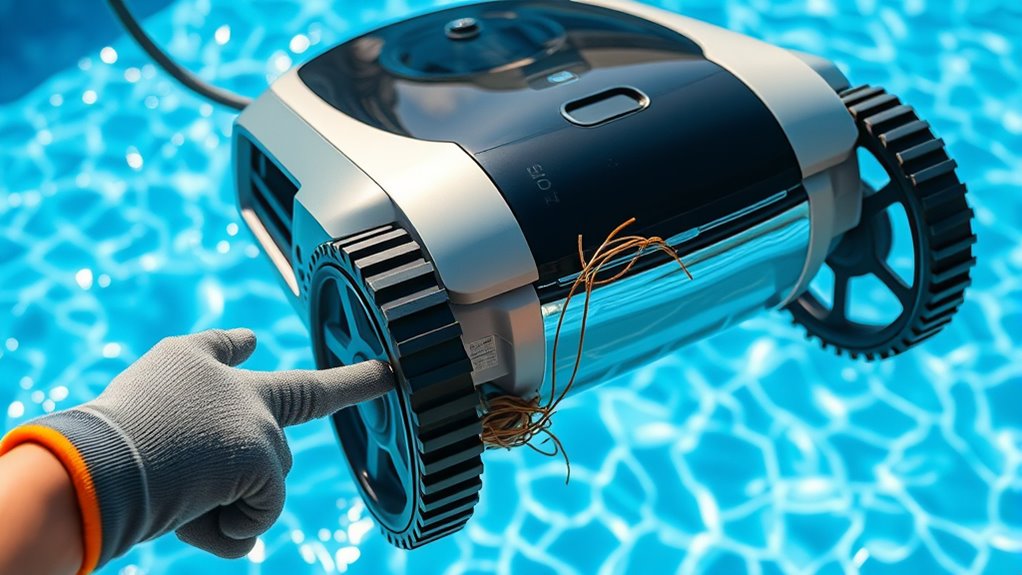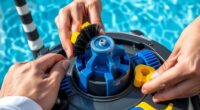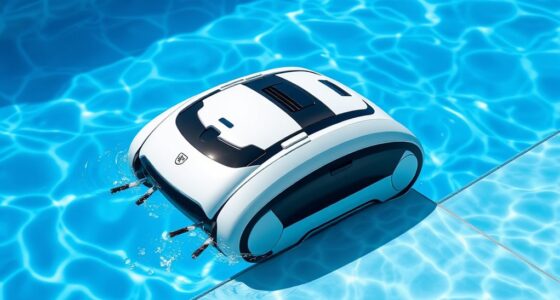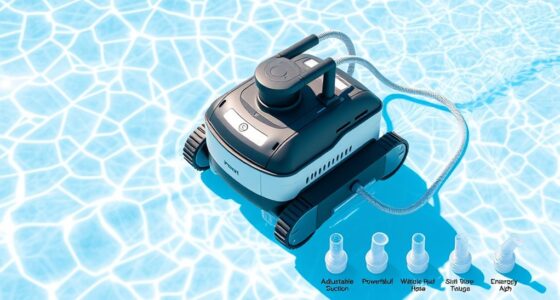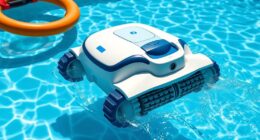If your robotic pool cleaner isn’t working properly, start by checking the power supply and charging station to verify it’s getting power and charging correctly. Look for obstructions, tangled brushes, or clogged filters that could block movement or affect cleaning. For error messages or noises, reset or update the device and inspect seals for leaks. Regular maintenance and calibration often fix common problems. Keep examining these areas, and you’ll find even more tips below to get your cleaner running smoothly.
Key Takeaways
- Check power connections and outlet functionality to resolve power and charging issues.
- Inspect brushes, wheels, and filters for debris or damage to improve movement and cleaning performance.
- Reset sensors and update firmware to fix navigation errors and obstacle detection problems.
- Examine seals, hoses, and fittings for leaks or damage to prevent water leaks and noise.
- Perform routine maintenance like cleaning filters and replacing worn parts for optimal operation.
Insufficient or No Power Supply
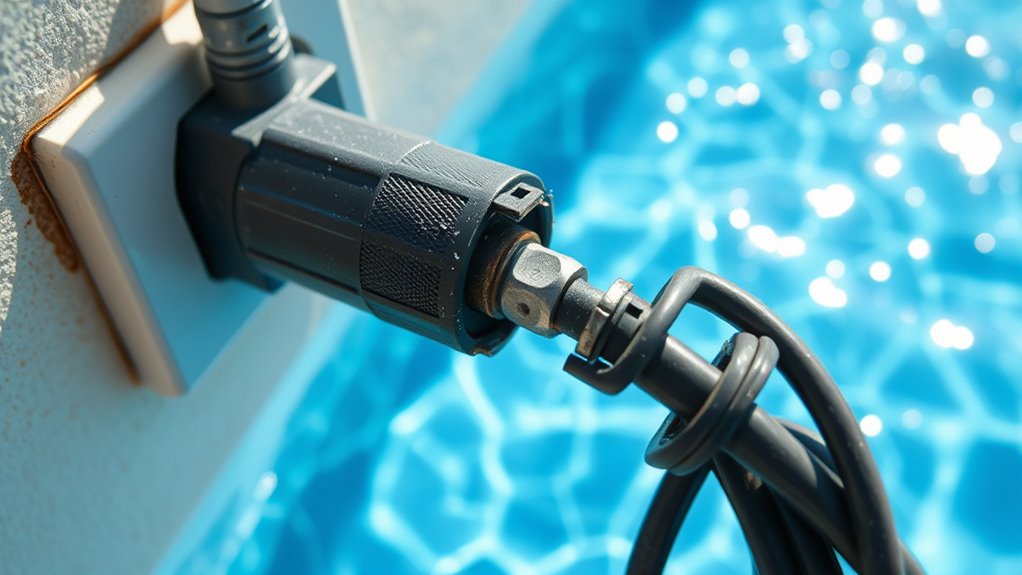
If your robotic pool cleaner isn’t starting or seems unresponsive, the most common cause is an insufficient or no power supply. First, check the power cable connected to the unit. Ensure it’s securely plugged into the electrical outlet. Sometimes, the cable may have become loose or disconnected, preventing power transfer. Next, inspect the outlet itself—plug in another device to confirm it’s working. If the outlet isn’t providing power, try plugging the cleaner into a different outlet. Also, look for any visible damage on the power cable, such as cuts or fraying. If you find damage or if the outlet isn’t functional, replacing the cable or resetting the circuit breaker might solve the issue. Without proper power, your robotic cleaner simply won’t operate. Additionally, verifying the power requirements of your specific model ensures compatibility and proper functioning. Regularly checking the electrical connections can help prevent this issue from recurring. Ensuring proper power supply is essential for optimal performance and longevity of your robotic pool cleaner. Confirming that the power source provides consistent voltage can also prevent sporadic operational problems.
The Cleaner Is Not Moving or Stuck
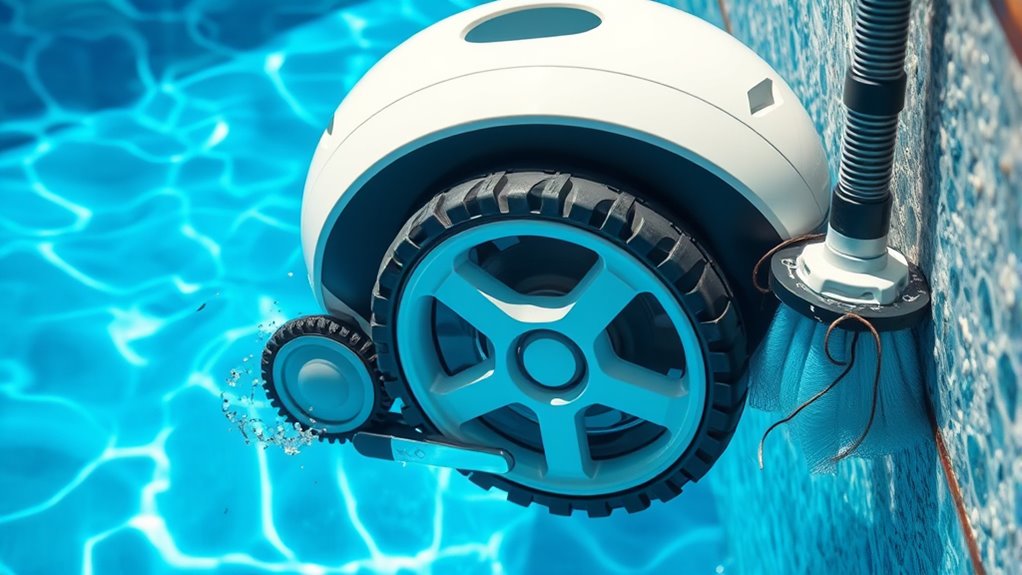
If your cleaner isn’t moving or gets stuck, check for any blockages or obstructions in its brushes or wheels. Also, confirm the power supply is steady and working properly, as issues there can cause it to stop. Addressing these common problems can often get your cleaner back to work quickly. Additionally, inspecting the filter condition and replacing filters as needed can help maintain optimal performance. Regular maintenance, including checking hoses and seals, can prevent leaks and ensure smooth operation. Understanding AI discoveries can also help in troubleshooting if your cleaner is affected by environmental factors or household interference.
Blockage or Obstruction
A blockage or obstruction is a common reason your robotic pool cleaner gets stuck or stops moving. To resolve this, start by inspecting the brushes, wheels, and intake area for debris. Check the filter and perform a filter replacement if it’s clogged, as this can hinder movement. Clear any leaves, hair, or dirt blocking the intake or wheels. Sometimes, a software update can improve navigation, so ensure your cleaner’s firmware is current. Also, examine the power cord and connections for tangles or damage. Ensuring the filtration system is functioning properly can significantly impact your cleaner’s performance and longevity. Regular maintenance of the airflow pathways can prevent future blockages and keep your pool cleaner operating smoothly. Properly maintaining the tuning and calibration of your robotic cleaner can also enhance its efficiency and durability. Additionally, verifying that the navigation system is correctly configured can help avoid repeated obstructions and improve overall operation.
Power Supply Issues
Even after clearing obstructions, your robotic pool cleaner might still not move if there’s an issue with its power supply. First, check the power cord for any damage or loose connections. A frayed or disconnected cord can prevent power from reaching the unit. If the power cord appears intact, the battery might be dead or faulty. Replacing the battery can restore power and ensure smooth operation. Make sure to use the manufacturer-recommended battery for compatibility. Also, verify that the power outlet is functioning properly by testing it with another device. If these steps don’t resolve the issue, consider inspecting the internal connections or seeking professional repair. Addressing power supply problems promptly can get your cleaner back to work efficiently. Regular maintenance and inspections can also help prevent future electrical issues, ensuring reliable performance. Additionally, checking for any corrosion or debris on the connectors can help maintain optimal electrical contact. Being aware of potential electrical failures can help you troubleshoot more effectively and prolong your cleaner’s lifespan.
Poor Cleaning Performance
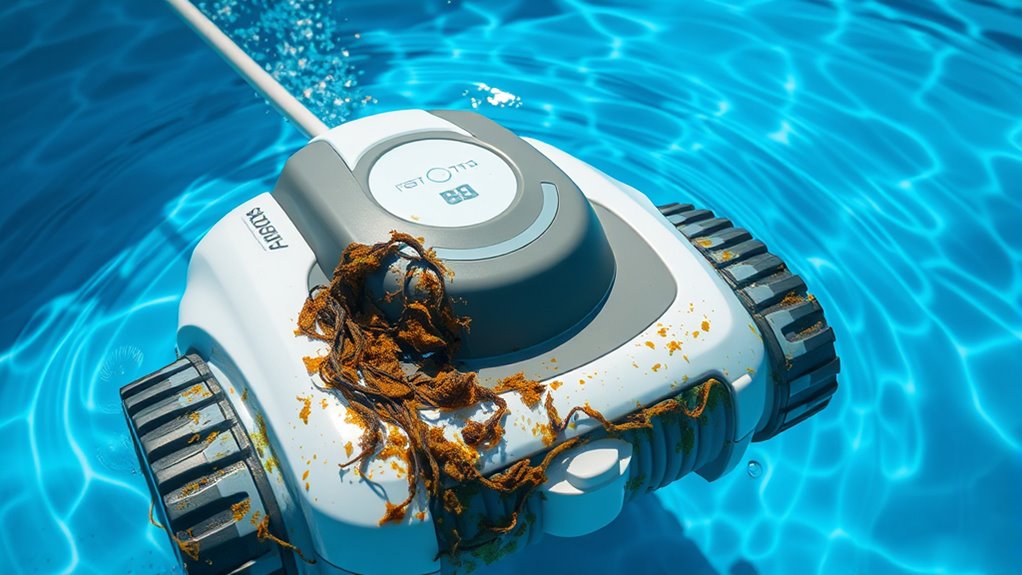
If your pool cleaner isn’t cleaning effectively, start by inspecting the brushes for wear and tear, and replace them if needed. Make certain there are no debris blockages that could hinder its movement or suction. Finally, check and adjust the navigation settings to ensure it covers the entire pool efficiently. Additionally, verify that the self-watering system is functioning properly to prevent any malfunctions that could affect its operation. Regularly inspecting filter performance can also help maintain optimal cleaning results and prevent buildup that reduces efficiency. To maximize effectiveness, also ensure that the navigation system is correctly calibrated for your pool’s shape and size. Proper system maintenance can further extend the lifespan and performance of your robotic pool cleaner.
Check Brush Condition
When your robotic pool cleaner isn’t scrubbing the pool floor effectively, checking the condition of its brushes is a crucial first step. Start with a thorough brush inspection to see if the bristles are worn, cracked, or missing. Damaged brushes reduce cleaning efficiency and may need replacing. Look for debris tangled in the bristles, which can hinder movement. If the brushes are heavily worn or damaged, perform a brush replacement to restore maximum performance. Also, ensure the brushes spin freely and aren’t stuck or obstructed. Regularly inspecting and replacing brushes when necessary keeps your cleaner working at its best. Remember, clean brushes lead to cleaner pools and less frustration during maintenance. Proper brush care is essential for consistent, effective cleaning results.
Clear Debris Blockages
Debris caught in the robotic pool cleaner’s pathways or brushes can markedly impair its cleaning performance. A common cause is filter obstruction, which restricts water flow and reduces suction power. Debris accumulation on the brushes or within the filter can cause the cleaner to miss spots or become stuck. To fix this, turn off the cleaner and inspect the filter for blockages. Remove and thoroughly clean the filter, ensuring no debris remains. Check the brushes for debris build-up or tangles, and clear them as needed. Clearing debris blockages improves water flow, boosts suction, and restores efficient cleaning. Regular maintenance of the filter and brushes prevents future obstructions, keeping your robotic pool cleaner operating at peak performance.
Optimize Navigation Settings
Poor cleaning performance often stems from suboptimal navigation settings, which can cause your robotic pool cleaner to miss areas or become stranded. To improve efficiency, focus on navigation optimization by adjusting control settings. Properly calibrated control settings ensure your cleaner covers the entire pool smoothly.
Consider these steps:
- Update the navigation algorithm if your model allows firmware updates
- Reset or recalibrate sensors to improve obstacle detection
- Switch between different cleaning modes for better coverage
- Set boundary markers or virtual walls to prevent stranded positions
The Cleaner Is Not Charging Properly

If your robotic pool cleaner isn’t charging properly, it can be frustrating to figure out why. First, check the battery health; a degraded battery won’t hold a charge. Ensure the cleaner is properly aligned with the charging station, and that the station’s contacts are clean and dry. Sometimes, debris or corrosion can prevent proper charging.
Use this quick reference:
| Issue | Solution |
|---|---|
| Dirty charging contacts | Clean contacts with a soft cloth |
| Faulty charging station | Test with a different station or replace if needed |
| Battery degradation | Replace the battery if it no longer holds charge |
| Misalignment with station | Position cleaner correctly on the station |
Address these areas to restore proper charging and maintain your cleaner’s performance.
Error Messages or Indicator Lights
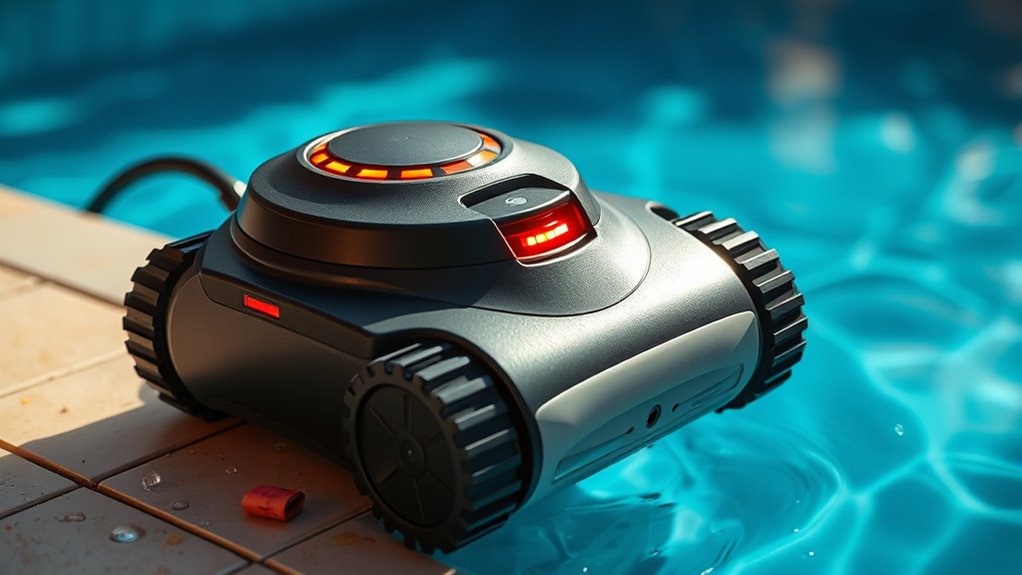
Have you noticed blinking lights or error codes on your robotic pool cleaner? These indicators help identify issues quickly. First, check if the software needs updates; outdated software can cause false alerts. Next, verify if the battery requires calibration—proper calibration ensures accurate operation and may clear error messages. Sometimes, indicator lights signal debris jams or sensor problems. To troubleshoot:
- Update your cleaner’s software via the manufacturer’s app or website
- Perform a battery calibration following the user manual
- Clear any debris blocking sensors or brushes
- Reset the device if error codes persist
Addressing these factors can resolve many common error messages. Remember, consistent software updates and battery calibration are key to smooth operation and minimizing false alarms.
The Brush or Roller Is Not Spinning
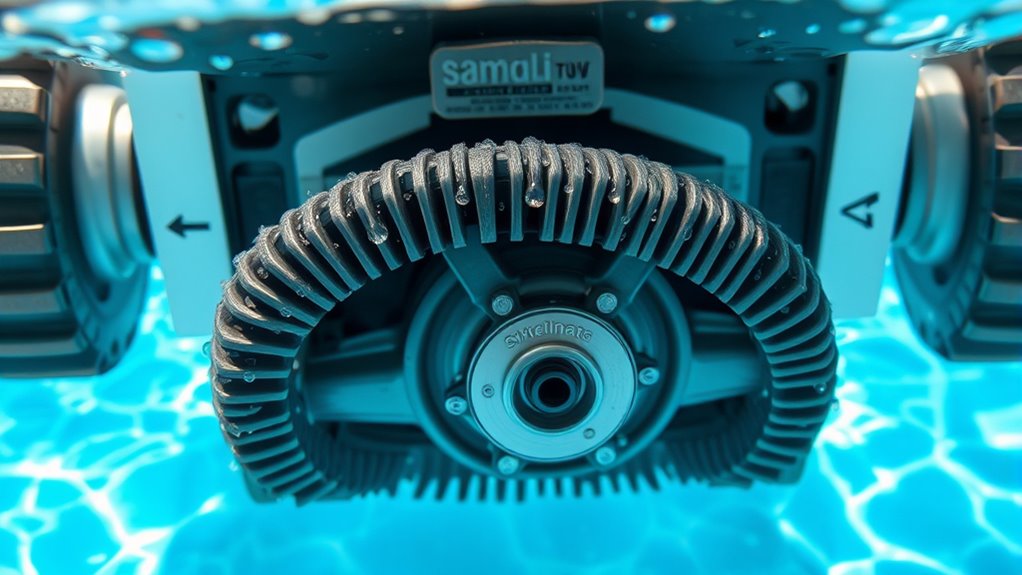
When your robotic pool cleaner’s brush or roller stops spinning, it can hinder its ability to scrub and collect debris effectively. First, check for tangled hair, debris, or buildup around the brush or roller, as these can block movement. Regular brush maintenance helps keep the roller spinning smoothly; clean the brushes thoroughly and remove any obstructions. If the brush or roller appears worn or damaged, consider replacing it to restore proper function. Sometimes, the motor or drive belt may be the issue, so inspect those components if cleaning and replacement don’t resolve the problem. Proper maintenance and timely roller replacement ensure your cleaner maintains ideal performance, preventing further issues with spinning or debris collection.
Water Leaks or Excessive Noise
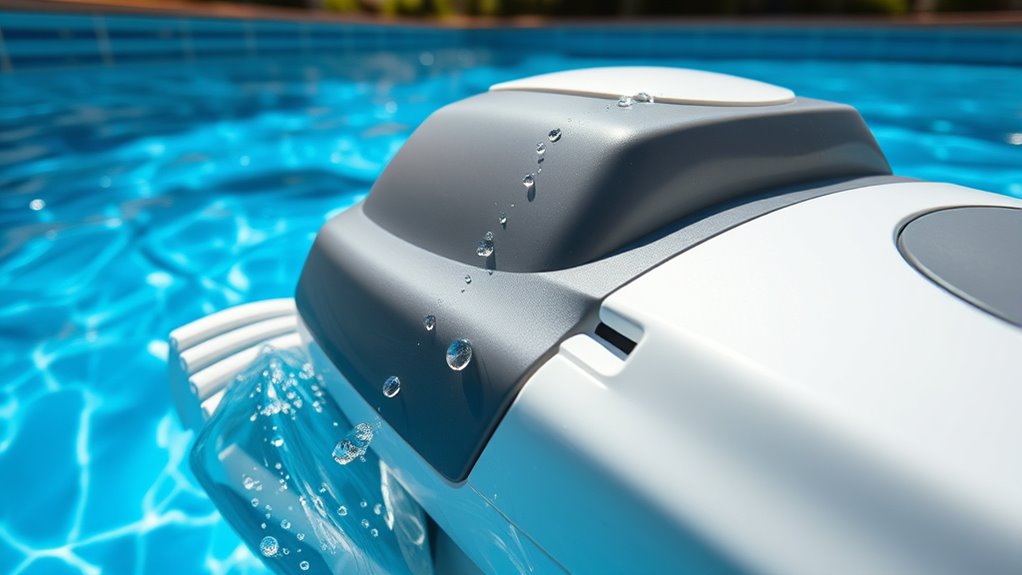
Water leaks and excessive noise are common signs that your robotic pool cleaner needs attention. Leaks can cause water damage to your equipment or surroundings, while loud noises suggest mechanical issues or poor noise reduction. To fix this, check for cracked seals or damaged hoses, as these are often the culprits. Ensure all fittings are tight and properly seated. Clean debris blocking vents or impellers that might cause noise. Replace worn-out seals or damaged parts promptly to prevent water leaks. Regular maintenance helps minimize water damage and keeps noise levels down. Taking these steps can improve your cleaner’s performance, prevent water damage, and ensure quieter operation. Addressing leaks and noise early keeps your pool cleaner working efficiently and extends its lifespan.
Remote Control or App Connectivity Issues
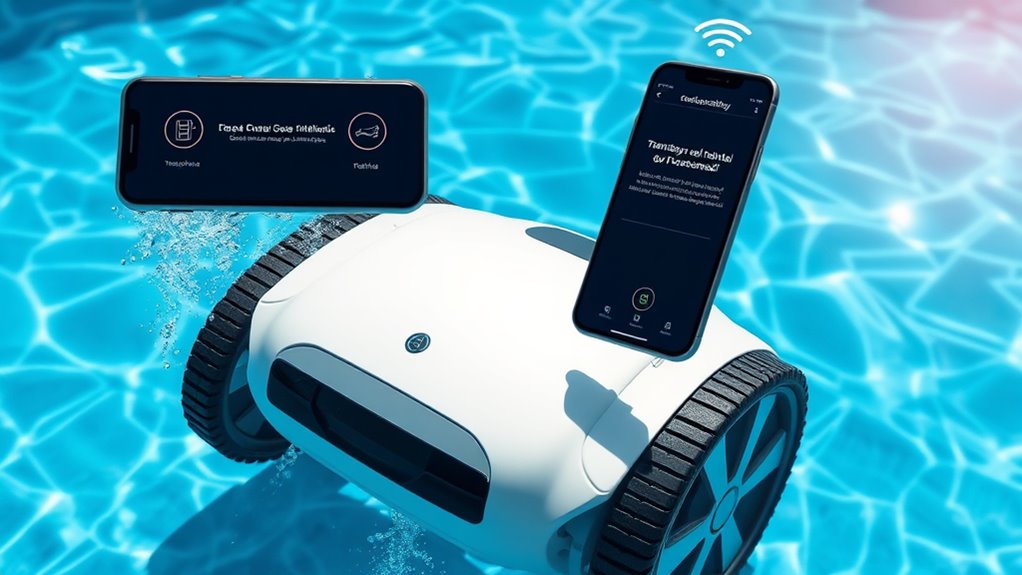
Connectivity issues with your remote control or app can disrupt your pool cleaner’s operation and leave you frustrated. First, check the remote connectivity by ensuring the batteries are fresh and the remote is within range. For app issues, verify that your device has the latest app updates installed, as outdated versions can cause connectivity problems. Restart your smartphone or tablet and reconnect to the Wi-Fi network, making sure your pool cleaner is also connected properly. Resetting the Wi-Fi module on the cleaner can resolve persistent issues. If problems persist, consult the user manual for specific reset instructions. Keeping your app updated and maintaining a clear connection will help ensure smooth remote control or app operation, minimizing downtime and maximizing your pool cleaner’s efficiency.
Regular Maintenance and Troubleshooting Tips
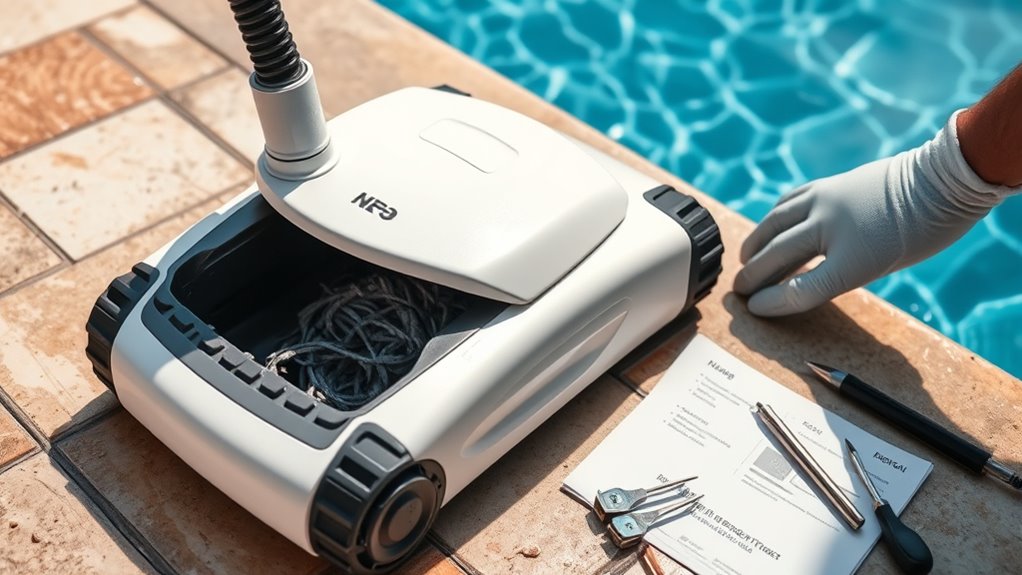
Regular maintenance is key to keeping your robotic pool cleaner running smoothly and preventing common issues. To guarantee peak performance, regularly check for software updates to improve functionality and fix bugs. Keep the brushes and filters clean to avoid clogs and buildup. If your cleaner isn’t holding a charge, consider battery replacement to restore power. Additionally, inspect the wheels and sensors for debris that might hinder movement.
Here are some tips to keep your cleaner in top shape:
- Update the software regularly for new features and fixes
- Replace the battery when it no longer holds a charge
- Clean brushes, filters, and sensors after each use
- Store the cleaner in a cool, dry place when not in use
Consistent maintenance prevents problems and extends your device’s lifespan.
Frequently Asked Questions
How Do I Reset My Robotic Pool Cleaner to Factory Settings?
To perform a factory reset on your robotic pool cleaner, first locate the reset button or follow the manufacturer’s specific instructions. Press and hold the reset button for a few seconds until you see the indicator lights or hear a beep, signaling the reset. This process restores your cleaner to factory settings and initiates system calibration, ensuring it functions properly. Always check your user manual for model-specific steps.
Can Debris Blockages Cause the Cleaner to Stop Unexpectedly?
Like a clogged artery, debris blockage can cause your robotic pool cleaner to stop unexpectedly. When debris buildup or filter clogging occurs, it restricts the cleaner’s movement and water flow. Regularly check and clear out debris from the filters and brushes. Removing debris prevents blockages, keeps your cleaner running smoothly, and guarantees it doesn’t halt mid-cleaning, saving you time and maintaining a sparkling pool.
What Is the Recommended Cleaning Schedule for Optimal Performance?
For ideal performance, you should establish regular maintenance routines and stick to a consistent cleaning frequency. Aim to clean your robotic pool cleaner at least once a week to remove debris and prevent buildup. Check for blockages and clean filters as needed, especially after heavy use or storms. Properly maintaining your cleaner ensures it runs efficiently, prolongs its lifespan, and keeps your pool sparkling clean all season long.
How Do I Update the Software or Firmware of My Robotic Cleaner?
To keep your robotic pool cleaner running smoothly, you need to stay on top of software updates and firmware installation. Check your user manual or manufacturer’s website for the latest updates. Usually, you’ll connect your cleaner to Wi-Fi or use a USB drive. Follow the prompts to download and install the software updates, ensuring your device has the newest features and bug fixes for peak performance.
Are There Specific Storage Tips to Prolong the Life of the Cleaner?
Think of your robotic pool cleaner as a fine wine that needs proper storage to age gracefully. To prolong its lifespan, follow these storage tips: keep it in a cool, dry place away from direct sunlight, avoid stacking heavy objects on top, and make sure it’s clean and dry before storing. Proper storage helps prevent damage and keeps your cleaner ready to plunge into action whenever you need it.
Conclusion
By following these troubleshooting tips, you can keep your robotic pool cleaner gliding smoothly through the water like a sleek swimmer slicing through the pool’s surface. Imagine it effortlessly sweeping away dirt and debris, sparkling under the sun’s rays. With a little patience and regular maintenance, your cleaner will stay in top shape, ensuring your pool remains crystal clear and inviting. Immerse yourself in your cleaning routine with confidence and enjoy a pristine pool all season long.
